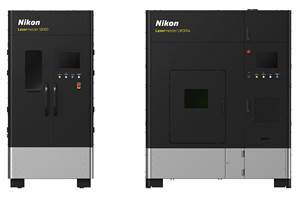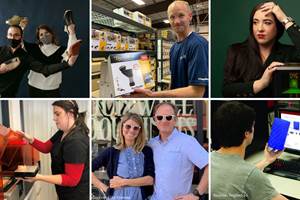Additive Manufacturing for Large Parts
Powder-bed fusion is driving the hype for additive manufacturing right now, but it may not be the best answer. Directed energy deposition is a strong contender.
For most of my columns, I focus on additive manufacturing (AM) using laser powder-bed fusion (PBF). This AM process is what is driving much of the hype given PBF’s ability to build complex and intricate shapes as well as organic structures that were previously too expensive or impossible to make via traditional manufacturing operations. For example, the design freedoms enabled by laser PBF can be exploited to lightweight components, to build intricate lattice structures for more efficient material usage, to consolidate multi-component assemblies and to optimize a part’s shape for functionality. Of course, laser PBF also has its drawbacks including difficult-to-remove support structures, thin-walled/high-aspect-ratio parts that might fail during a build, layering effects on surface roughness and different process parameter settings (e.g., laser settings for up-skin versus down-skin surfaces).
Despite PBF’s many advantages, its big limitation is the size of the part that can be printed in the build envelope. For a variety of reasons, most commercial laser PBF systems offer a build envelope measuring 250 by 250 by 325 mm (roughly 10 by 10 by 12 inches), though some laser PBF systems can accommodate taller parts, and larger systems are in development. For instance, GE’s Concept Laser X Line 2000R boasts an 800 by 400 by 500 mm build envelope, and the company plans to build a system that starts at 1.1 by 1.1 by 0.3 meters.
One of the reasons laser PBF systems limit the size of the build envelope is because of the cost of the powder needed to fill the machine. If you recall from my previous discussion on AM economics, the amount of powder needed to fill a laser PBF machine is equal to l x w x h (the area of the build plate times the height of the part), and you have to load that amount of powder into the machine no matter how many parts you are fabricating on the build plate. So, the height of the tallest part dictates the volume of powder that is needed to fill the machine independent of the production quantity.
While larger build plates or taller build heights are certainly possible, the cost of powder quickly becomes astronomical. Two of my colleagues in CIMP-3D, our metal additive manufacturing lab at Penn State, estimated that building a 6-inch-tall component in Ti-6Al-4V on a 10- by 10-inch build plate required nearly $50,000 in powder about three to four years ago. Granted, the cost of Ti-6Al-4V powder has come down 30 to 40 percent since that time, but that is still an exorbitant expense—one that you have to pay whether you are making one part of hundreds of parts on a given build plate.
So how can companies afford to manufacture larger parts directly with AM? Directed energy deposition (DED) provides a promising alternative to PBF. In this AM process, a laser (or electron or plasma) beam is used to create a melt pool into which powder is blown or wire is fed. As the powder or wire enters the melt pool, it heats up, melts, bonds to adjacent material and the layer/s below, and then rapidly solidifies as the melt pool moves away.
Because you are feeding powder or wire directly into the melt pool, you do not have to fill the whole build envelope like you do with PBF. In this case, the material cost scales directly with the volume of the part. Granted, powder capture rates (the amount of powder blown by the nozzles versus the amount of powder captured in the melt pool) can typically vary from 40 to 80 percent based on laser parameters, but even then you only need 2.5 to 1.25 times the amount of powder, respectively, to build the part with DED versus a volume of powder defined by the build height. With wire, it is even better as the melt pool can be sized to melt the whole wire.
The other big challenge when it comes to part size is build speed, and again, DED wins over PBF. Laser PBF typically uses a spot size of 50 to 100 microns when building parts, however, spot size on laser-based DED systems can range from about 0.5 to 3.0 mm on commercial systems. Large spot size means a higher deposition rate, which means a faster build. Among the fastest DED systems is Sciaky’s electron beam additive manufacturing (EBAM) systems, which can deposit 15 to 20 pounds of titanium per hour using a wire melted by an electron beam. The accompanying figure from my colleague Dr. Richard Martukanitz, director of CIMP-3D at Penn State, provides a nice comparison of the different deposition rates.
So what is the downside of DED? Imagine that you are painting a wall in a room. PBF is like painting the entire wall with a very fine paint brush. It would be very accurate in the corners and along the edges, but it would take a long time to paint the wall itself. DED, on the other hand, is like using a roller, which covers a lot of area fast, but loses accuracy on the edges and corners. As such, DED can build parts faster using less material, but DED parts will require extensive machining and finishing to meet tolerances.
Related Content
Nikon Lasermeister Metal DED 3D Printer and Scanner Developed for Industrial Applications, Turbine Blade Repair
This technology gives manufacturers the ability to build onto existing parts with high precision and utilize a variety of materials, reducing lead times and minimizing postprocessing requirements.
Read More3D Printed Seal for Geothermal Power: The Cool Parts Show #73
Plugging a hole is a complex challenge when it’s a well for geothermal power. Additive manufacturing produces a shape-changing stainless steel seal for high-temperature applications deep underground.
Read MoreResearchers Use Additive Manufacturing to Make Aircraft Propulsion Systems More Eco-Friendly
Project researchers aim to utilize hydrogen fuel cells and additive manufacturing as a pathway to achieve low-emission aviation by 2050. The goal is to recuperate the waste heat of a fuel cell-electric propulsion system, paving the way for a clearer, more sustainable future in aviation.
Read More8 Transformations 3D Printing Is Making Possible
Additive manufacturing changes every space it touches; progress can be tracked by looking for moments of transformation. Here are 8 places where 3D printing is enabling transformative change.
Read MoreRead Next
Profilometry-Based Indentation Plastometry (PIP) as an Alternative to Standard Tensile Testing
UK-based Plastometrex offers a benchtop testing device utilizing PIP to quickly and easily analyze the yield strength, tensile strength and uniform elongation of samples and even printed parts. The solution is particularly useful for additive manufacturing.
Read More3D Printed Polymer EOAT Increases Safety of Cobots
Contract manufacturer Anubis 3D applies polymer 3D printing processes to manufacture cobot tooling that is lightweight, smooth and safer for human interaction.
Read MoreAlquist 3D Looks Toward a Carbon-Sequestering Future with 3D Printed Infrastructure
The Colorado startup aims to reduce the carbon footprint of new buildings, homes and city infrastructure with robotic 3D printing and a specialized geopolymer material.
Read More




















